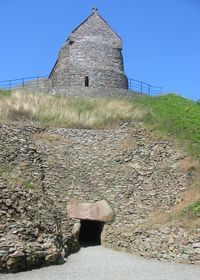La Hougue Bie
 |
|
| Coordinates | 49°12′02″N 2°03′50″W / 49.2006°N 2.0638°W |
|---|---|
| Public transit access | Bus route 13 |
| Nearest car park | On site (no charge) |
| Website | www |
La Hougue Bie is a historic site, with museum, in the Jersey parish of Grouville. Hougue is a Jèrriais/Norman language word meaning a "mound" and comes from the Old Norse word haugr.Bie is of uncertain origin. The legend of La Hougue Bie connects it with the Seigneur of Hambye in the Cotentin; an Old Norse origin may connect it to -by toponyms in Great Britain; or it may be connected to the Jèrriais word bié (leat).
La Hougue Bie is depicted on the 2010 issue Jersey 1 pound note.
The site consists of an 18.6 metre long passage chamber covered by a 12.2 metre high earth mound. The site was first excavated in 1925 by the Société Jersiaise. Fragments of twenty vase supports were found along with the scattered remains of at least eight individuals. Gravegoods, mostly pottery, were also present. At some time in the past, the site had evidently been entered and ransacked. On top of the mound were built two Medieval chapels. The Channel Islands (in contrast with mainland Brittany, where they are rare), have five passage graves with side chambers (La Hougue Bie, Faldouet and Grantez in Jersey, La Varde and Le Déhus in Guernsey).
La Hougue Bie is a Neolithic ritual site which was in use around 3500 BC. In Western Europe, it is one of the largest and best preserved passage graves and the most impressive and best preserved monument of Armorican Passage Grave group. Although they are termed "passage graves", they were ceremonial sites, whose function was more similar to churches or cathedrals, where burials were incidental. Since the excavations and restoration of the original entrance of the passage observations from inside the tomb at sunrise on the spring and autumn equinox have revealed that the orientation of the passage allows the sun's rays to shine through to the chamber entering the back recess of the terminal cell. Although many passage graves showed evidence of continued activity into the Late Neolithic period, La Hougue Bie was abandoned before that time.
...
Wikipedia
